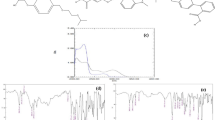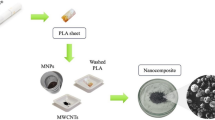Abstract
An efficient analytical method based on molecularly imprinted solid-phase extraction (MISPE) coupled with high-performance liquid chromatography-diode array detection (HPLC-DAD) was established for the determination of iridoid glycosides (IGs) in Di-huang pills. As the solid-phase extraction medium, superhydrophilic molecularly imprinted polymers (MIPs) with high affinity and selectivity to IGs in water media were fabricated using divinyl galactose as a single cross-linking monomer. The structure, porosity, and hydrophilicity of MIPs were characterized. The properties involving dynamic adsorption, kinetic adsorption, and selectivity were evaluated. Under optimal conditions the MISPE-HPLC-DAD based method was applied for loganin, morroniside, cornin, and sweroside determination in three kinds of Di-huang pills. The limits of detection of four IGs were 0.002–0.003 mg g−1. Furthermore, the proposed method exhibited some merits including good linearity, excellent precision, and desirable accuracy. The established MISPE-HPLC-DAD method has great potential for the selective determination of IGs in Chinese patent drugs.

ᅟ








Similar content being viewed by others
References
Chen L, Xu S, Li J. Recent advances in molecular imprinting technology: current status, challenges and highlighted applications. Chem Soc Rev. 2011;40:2922–42.
Chen L, Wang X, Lu W, Wu X, Li J. Molecular imprinting: perspectives and applications. Chem Soc Rev. 2016;45:2137–211.
Liang S, Yan H, Cao J, Han Y, Shen S, Bai L. Molecularly imprinted phloroglucinol-formaldehyde-melamine resin prepared in a deep eutectic solvent for selective recognition of clorprenaline and bambuterol in urine. Anal Chim Acta. 2017;951:68–77.
Díaz-Álvarez M, Martín-Esteban A. Hollow fiber membrane-protected molecularly imprinted microspheres for micro solid-phase extraction and clean-up of thiabendazole in citrus samples. J Chromatogr A. 2018;1531:39–45.
Rossetti C, Ore OG, Sellergren B, Halvorsen TG, Reubsaet L. Exploring the peptide retention mechanism in molecularly imprinted polymers. Anal Bioanal Chem. 2017;409:5631–43.
Jia M, Yang J, Sun Y, Bai X, Wu T, Liu Z, et al. Improvement of imprinting effect of ionic liquid molecularly imprinted polymers by use of a molecular crowding agent. Anal Bioanal Chem. 2018;410:595–604.
Sun Y, Pang Y, Zhang J, Li Z, Liu J, Wang B. Application of molecularly imprinted polymers for the analysis of polycyclic aromatic hydrocarbons in lipid matrix-based biological samples. Anal Bioanal Chem. 2017;409:6851–60.
Sun Y, Zhong S. Molecularly imprinted polymers fabricated via Pickering emulsions stabilized solely by food-grade casein colloidal nanoparticles for selective protein recognition. Anal Bioanal Chem. 2018; https://doi.org/10.1007/s00216-018-1006-x.
Ye L. Molecularly imprinted polymers with multi-functionality. Anal Bioanal Chem. 2016;408:1727–33.
Guo P, Yuan X, Zhang J, Wang B, Sun X, Chen X, et al. Dummy-surface molecularly imprinted polymers as a sorbent of micro-solid-phase extraction combined with dispersive liquid–liquid microextraction for determination of five 2-phenylpropionic acid NSAIDs in aquatic environmental samples. Anal Bioanal Chem. 2018;410:373–89.
Sibrian-Vazquez M, Spivak DA. Molecular imprinting made easy. J Am Chem Soc. 2004;126:7827–33.
Sibrian-Vazquez M, Spivak DA. Enhanced enantioselectivity of imprinted polymers formulated with novel crosslinking monomers. Macromolecules. 2003;36:5105–13.
Wei Z, Wu X, Zhang B, Li R, Huang Y, Liu Z. Coatings of one monomer molecularly imprinted polymers for open tubular capillary electrochromatography. J Chromatogr A. 2011;1218:6498–504.
Sibrian-Vazquez M, Spivak DA. Improving the strategy and performance of molecularly imprinted polymers using cross-linking functional monomers. J Organomet Chem. 2003;68:9604–11.
Yoshimatsu K, LeJeune J, Spivak DA, Ye L. Peptide-imprinted polymer microspheres prepared by precipitation polymerization using a single bi-functional monomer. Analyst. 2009;134:719–24.
Boros CA, Stemrmitz FR. Iridoids. An updated review. Part I. J Nat Prod. 1990;53:1055–147.
Boros CA, Stemrmitz FR. Iridoids. An updated review. Part II. J Nat Prod. 1991;54:1173–246.
Chinese Pharmacopoeia Commission. Chinese pharmacopoeia, vol. I. Beijing: People’s Medical Publishing House; 2015. p. 704–−705.
Chinese Pharmacopoeia Commission. Chinese pharmacopoeia, vol. I. Beijing: People’s Medical Publishing House; 2015. p. 775–−777.
Chinese Pharmacopoeia Commission. Chinese pharmacopoeia, vol. I. Beijing: People’s Medical Publishing House; 2015. p. 935–−936.
Song Y, Li SL, Wu MH, Li HJ, Li P. Qualitative and quantitative analysis of iridoid glycosides in the flower buds of Lonicera species by capillary high performance liquid chromatography coupled with mass spectrometric detector. Anal Chim Acta. 2006;564:211–8.
Cao XY, Wang ZZ. Simultaneous determination of four iridoid and secoiridoid glycosides and comparative analysis of Radix Gentianae macrophyllae and their related substitutes by HPLC. Phytochem Anal. 2010;21:348–54.
Yang L, Wang Y, Wang L, Xiao H, Wang Z, Hu Z. Rapid quantification of iridoid glycosides analogues in the formulated Chinese medicine Longdan Xiegan decoction using high-performance liquid chromatography coupled with mass spectromentry. J Chromatogr A. 2009;1216:2098–103.
He ML, Cheng XW, Chen JK, Zhou TS. Simultaneous determination of five major biologically active ingredients in different parts of Gardenia jasminoides fruits by HPLC with diode-array detection. Chromatographia. 2006;64:713–7.
Zhao M, Tao J, Qian D, Liu P, Shang E, Jiang S, et al. Simultaneous determination of loganin, morroniside, catalpol and acteoside in normal and chronic kidney disease rat plasma by UPLC–MS for investigating the pharmacokinetics of Rehmannia glutinosa and Cornus officinalis Sieb drug pair extract. J Chromatogr B. 2016;1009–1010:122–9.
Li H, Li P, Ye W. Determination of five major iridoid glucosides in Flos Lonicerae by high-performance liquid chromatography coupled with evaporative light scattering detection. J Chromatogr A. 2003;1008:167–72.
Du W, Cai H, Wang M, Ding X, Yang H, Cai B. Simultaneous determination of six active components in crude and processed Fructus Corni by high performance liquid chromatography. J Pharm Biomed Anal. 2008;48:194–7.
Si W, Yang W, Guo D, Wu J, Zhang J, Qiu S, et al. Selective ion monitoring of quinochalcone C-glycoside markers for the simultaneous identification of Carthamus tinctorius L. in eleven Chinese patent medicines by UHPLC/QTOF MS. J Pharm Biomed Anal. 2016;117:510–21.
Yao C, Yang W, Wu W, Da J, Hou J, Zhang J, et al. Simultaneous quantitation of five Panax notoginseng saponins by multi heart-cutting two-dimensional liquid chromatography: method development and application to the quality control of eight Notoginseng containing Chinese patent medicines. J Chromatogr A. 2015;1402:71–81.
Zhao J, Ma S, Li S. Advanced strategies for quality control of Chinese medicines. J Pharm Biomed Anal. 2018;147:473–8.
Ji W, Zhang M, Wang D, Wang X, Liu J, Huang L. Superhydrophilic molecularly imprinted polymers based on a water-soluble functional monomer for the recognition of gastrodin in water media. J Chromatogr A. 2015;1425:88–96.
Kong XJ, Zheng C, Lan YH, Chi SS, Dong Q, Liu HL, et al. Synthesis of multirecognition magnetic molecularly imprinted polymer by atom transfer radical polymerization and its application in magnetic solid-phase extraction. Anal Bioanal Chem. 2018;410:247–57.
Gao SP, Zhang X, Zhang LS, Huang YP, Liu ZS. Molecularly imprinted polymer prepared with polyhedral oligomeric silsesquioxane through reversible addition–fragmentation chain transfer polymerization. Anal Bioanal Chem. 2017;409:3741–8.
Ji W, Sun R, Geng Y, Liu W, Wang X. Rapid, low temperature synthesis of molecularly imprinted covalent organic frameworks for the highly selective extraction of cyano pyrethroids from plant samples. Anal Chim Acta. 2018;1001:179–88.
Wang N, Wang YF, Omer AM, Ouyang X. Fabrication of novel surface-imprinted magnetic graphene oxide-grafted cellulose nanocrystals for selective extraction and fast adsorption of fluoroquinolones from water. Anal Bioanal Chem. 2017;409:6643–53.
Dima ŞO. Equilibrium and kinetic isotherms and parameters for molecularly imprinted with sclareol poly(acrylonitrile-co-acrylic acid) matrix. Polym Eng Sci. 2015;55:1152–62.
Umpleby RJ, Baxter SC, Chen Y, Shah RN, Shimizu KD. Characterization of molecularly imprinted polymers with the Langmuir-Freundlich isotherm. Anal Chem. 2001;73:4548–91.
Ji W, Wang T, Liu W, Liu F, Guo L, Geng Y, et al. Water-compatible micron-sized monodisperse molecularly imprinted beads for selective extraction of five iridoid glycosides from Cornus officinalis fructus. J Chromatogr A. 2017;1504:1–8.
Ji W, Zhang M, Liu W, Wang X, Duan W, Xie H, et al. Development of hydrophilic magnetic molecularly imprinted polymers by directly coating onto Fe3O4 with a water-miscible functional monomer and application in a solid-phase extraction procedure for iridoid glycosides. RSC Adv. 2016;6:50487–96.
Ji W, Zhang M, Gao Q, Cui L, Chen L, Wang X. Preparation of hydrophilic molecularly imprinted polymers via bulk polymerization combined with hydrolysis of ester groups for selective recognition of iridoid glycosides. Anal Bioanal Chem. 2016;408:5319–28.
Acknowledgments
Financial support from the National Natural Science Foundation of China (No. 81603286), the Key Science and Technology Program of Shandong (No. 2016GSF202033), the Natural Science Foundation of Shandong (ZR2016YL006), the Priority Research Program of the Shandong Academy of Sciences (Lanping Guo), and the Shandong Province Taishan Scholar Program (Lanping Guo) are acknowledged.
Author information
Authors and Affiliations
Corresponding author
Ethics declarations
Conflict of interest
The authors declare that they have no conflict of interest.
Rights and permissions
About this article
Cite this article
Ji, W., Wang, R., Mu, Y. et al. Superhydrophilic molecularly imprinted polymers based on a single cross-linking monomer for the recognition of iridoid glycosides in Di-huang pills. Anal Bioanal Chem 410, 6539–6548 (2018). https://doi.org/10.1007/s00216-018-1257-6
Received:
Revised:
Accepted:
Published:
Issue Date:
DOI: https://doi.org/10.1007/s00216-018-1257-6




